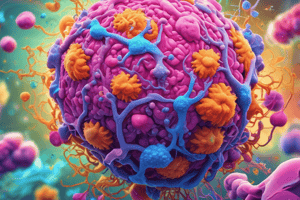Podcast
Questions and Answers
What is the first critical step that a virus must accomplish to initiate an infection within a host cell?
What is the first critical step that a virus must accomplish to initiate an infection within a host cell?
- Suppressing the host cell's metabolic processes to conserve energy.
- Altering the host cell's DNA to prevent immune detection.
- Hijacking the host cell's ribosomes for immediate viral protein synthesis.
- Attaching to the cell surface and penetrating the cell. (correct)
Which of the following best describes viral pathogenesis?
Which of the following best describes viral pathogenesis?
- The integration of viral DNA into the host cell's genome.
- The activation of antiviral cytokines by the host immune system.
- The rapid mutation of a virus to evade host immune responses.
- The process by which a viral infection leads to the development of disease. (correct)
Through which primary routes do virions typically initiate implantation onto living cells in a host?
Through which primary routes do virions typically initiate implantation onto living cells in a host?
- Direct injection into the bloodstream, ensuring rapid systemic distribution.
- Ocular, auditory, and olfactory pathways, bypassing the immune system.
- Respiratory, gastrointestinal, skin-penetrating, and genital routes. (correct)
- Transplacental transmission from mother to fetus, establishing congenital infection.
What distinguishes viremic spread from neural dissemination in viral infections?
What distinguishes viremic spread from neural dissemination in viral infections?
During viral infection, what is the significance of the virus spreading to sites of shedding into the environment?
During viral infection, what is the significance of the virus spreading to sites of shedding into the environment?
Which of the following is a false statement regarding viral spread?
Which of the following is a false statement regarding viral spread?
What facilitates vial spread to target organs?
What facilitates vial spread to target organs?
Which of the following is a true statement with regards to implantation of virions?
Which of the following is a true statement with regards to implantation of virions?
Flashcards
Initiation of Infection
Initiation of Infection
The process where a virus attaches, penetrates, and uncoats to infect a cell.
Viral Pathogenesis
Viral Pathogenesis
The process by which an infection leads to disease caused by a virus.
Portal of Entry
Portal of Entry
The route through which a virus enters the host organism.
Local Replication
Local Replication
Signup and view all the flashcards
Viremic Spread
Viremic Spread
Signup and view all the flashcards
Neurological Dissemination
Neurological Dissemination
Signup and view all the flashcards
Sites of Shedding
Sites of Shedding
Signup and view all the flashcards
Pathogenic Mechanisms
Pathogenic Mechanisms
Signup and view all the flashcards
Study Notes
Viral Infection Initiation
- Viruses must attach to a host cell, penetrate it, and become uncoated to access their genome for replication.
Viral Pathogenesis
-
Pathogenesis describes how a viral infection causes disease.
-
Key mechanisms include:
- Implantation: Viruses attach to host cells at entry points (respiratory, gastrointestinal, skin, genital).
- Local Replication: Viruses often replicate within cells, some also spread extracellularly.
- Spread to Target Organs:
- Viremic Spread: The most common route, viruses travel through the bloodstream (via lymphatics) to reach target sites.
- Neural Dissemination: Some viruses (e.g., rabies, herpes, polio) spread along nerves.
- Shedding: Viruses are released from the body at various sites (respiratory, alimentary, urogenital, blood).
Studying That Suits You
Use AI to generate personalized quizzes and flashcards to suit your learning preferences.




